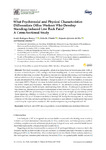What psychosocial and physical characteristics differentiate offce workers who develop standing-induced low back pain? a cross-sectional study

Ver/
Use este enlace para citar
http://hdl.handle.net/2183/26344
A non ser que se indique outra cousa, a licenza do ítem descríbese como Creative Commons Attribution 4.0 International Licence (CC-BY 4.0)
Coleccións
- GI-IPRF - Artigos [152]
Metadatos
Mostrar o rexistro completo do ítemTítulo
What psychosocial and physical characteristics differentiate offce workers who develop standing-induced low back pain? a cross-sectional studyData
2020-09-28Cita bibliográfica
Rodríguez-Romero B, Smith MD, Quintela-del-Rio A, Johnston V. What psychosocial and physical characteristics differentiate offce workers who develop standing-induced low back pain? a cross-sectional study. Int. J. Environ. Res. Public Health. 2020; 17(19):7104.
Resumo
[Abstract]
This study examines demographic, physical and psychosocial factors associated with an
increase in low back pain (LBP) during a one-hour standing task. A cross-sectional survey with
40 o ce workers was conducted. The primary outcome was pain severity during a one-hour standing
task recorded every 15 min using a 100 mm Visual Analogue Scale (VAS). Participants were defined
as pain developers (PD), if they reported a change in pain of 10 mm from baseline, or non-pain
developers (NPD). Physical outcomes included participant-rated and examiner-rated trunk and
hip motor control and endurance. Self-report history of LBP, physical activity, psychosocial job
characteristics, general health and pain catastrophising were collected. Fourteen participants were PD.
Hip abduction, abdominal and spinal muscle endurance was lower for PD (p 0.05). PD had greater
self-reported di culty performing active hip abduction and active straight leg raise tests (p 0.04).
Those reporting a lifetime, 12 month or 7-day history of LBP (p < 0.05) and lower self-reported
physical function (p = 0.01) were more likely to develop LBP during the standing task. In conclusion,
a history of LBP, reduced trunk and hip muscle endurance and deficits in lumbopelvic/hip motor
control may be important to consider in o ce workers experiencing standing-induced LBP.
Palabras chave
Low back pain (LBP)
Standing position
Musculoskeletal pain
Sedentary behaviour
Standing position
Musculoskeletal pain
Sedentary behaviour
Versión do editor
Dereitos
Creative Commons Attribution 4.0 International Licence (CC-BY 4.0)
ISSN
1661-7827






